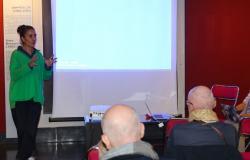
Confrontation of worlds of women
Resistant to classifications that would restrict her desire for movement, Elisabeth Barillé has a career punctuated by various prizes where, mixing novels, essays, reports, biographies and critiques – she was interested in Anaïs Nin as well as in the Russia of her great -father –, she made her mark, from her girl’s body published in 1988, a rather controversial entry into the Parisian literary world. If his recent novel does not deserve this label, it is no less singular in the questions that emanate from it.
Two sisters, then. Faced with their life choices. Lucie, spontaneous, cheerful, disorderly, rebels against injunctions and conventions, loves traveling, flashiness, designing a magical world that dazzles her elder sister. This one whose first name we will never know is the narrator. More stable and thoughtful, she likes to write and is worried about her younger daughter, whom she does not understand what motivated her to leave everything to go to Dubai, a luxury city where she has no base. Shaken by her ability to reject objects from the family past, she knows she has been weakened by an unfortunate play on words from her father which has cut her raw. She then plunges, by chance, into research on Madeleine Françoise Basseporte, a very real naturalist artist from the 18th century who, born without a future, made her way, through hard work and originality, to the king’s court. , and she finds a diversion there. A sort of mirror absorbing her reflections while freeing her from her concerns.
Beyond oblivion
Three women finally. Which are reflected across time and places. The additional characters who support the browser in her investigations and the questions that haunt her do not add much to the story and distract from the essentials to the point of, sometimes, weariness.
Probing the imagination of the artist attached to the living that she frequently calls Miss B, she brings her back to life beyond the oblivion which was often the fate of recognized women of the past. This is one of the interests of the book. The other is in the confrontation of three worlds of women, perhaps more linked than one might believe. As if Elisabeth Barillé found herself or sought herself a little in each. As if she draws peace from the enigmas that trouble her. What did Lucie run away from? What motivated Madeleine Françoise? The novelist, who published a Little praise of the sensitive in 2008, goes there with finesse, without affectation or excess, probing beyond time, places and appearances, the effervescences and the imponderables of the human spirit.
⇒ Sisters and other living species | Roman | Elisabeth Barillé | Arléa, 198 pp., €20
EXTRACT
“We had both been raised to respect bourgeois standards, I had adhered to them, not Lucie, not at all. Lucie can barely stand on her little legs when she begins to tame the use of word “no” and the power that emanates from it. Like obstacles for racehorses, norms are incentives for her to jump… Transgressing is natural to her.





